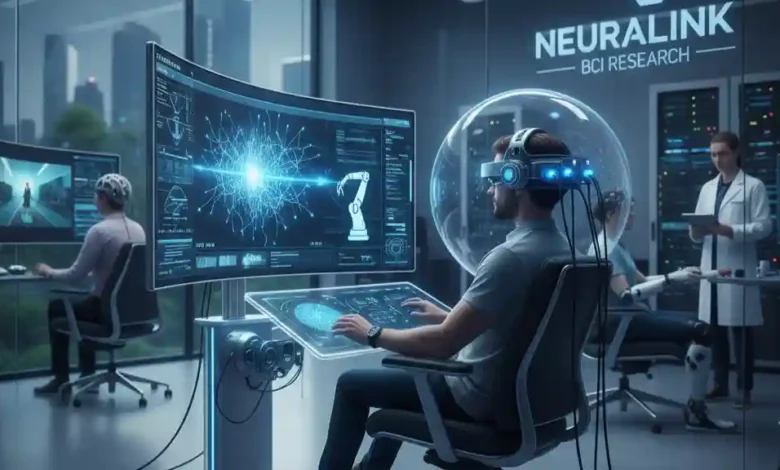How Brain-Computer Interfaces (BCIs) are Rewriting the Future of Humanity

Imagine a world where your thoughts alone can move objects, control complex machinery, or even communicate directly with others, transcending the need for words. This isn’t science fiction; it’s the rapidly unfolding reality of Brain-Computer Interfaces (BCIs). These revolutionary technologies are poised to redefine what it means to be human, offering unprecedented potential for healing, augmentation, and connection. Are you ready to dive into the astonishing future where your mind becomes the ultimate interface?
The Dawn of Direct Thought Control: What Exactly are Brain-Computer Interfaces (BCIs)
At its core, a Brain-Computer Interface is a direct communication pathway between an enhanced or wired brain and an external device. Think of it as a translator: it deciphers the electrical signals generated by your brain – the very language of your thoughts and intentions – and converts them into commands that a computer or robotic limb can understand. This bypasses the traditional pathways of peripheral nerves and muscles, opening up a direct neural bridge to the digital world.
How Do They Work Their Magic? A Glimpse Under the Hood
BCIs operate on a fascinating principle: your brain constantly generates electrical impulses. Different thoughts, intentions, and even sensory experiences create unique patterns of these electrical signals. BCIs are designed to detect, record, and interpret these patterns.
There are two primary categories of BCIs, each with its own advantages and applications:
- Invasive BCIs: These require surgical implantation of electrodes directly into the brain. While this sounds daunting, invasive BCIs offer the highest resolution and signal quality, making them incredibly powerful for precise control. Examples include:
- Electrocorticography (ECoG): Electrodes are placed on the surface of the brain.
- Microelectrode Arrays: Tiny electrodes are inserted into specific brain regions, like the motor cortex.
- Advantages: Superior signal-to-noise ratio, high spatial resolution, and long-term stability.
- Disadvantages: Surgical risks, potential for infection, and ethical considerations.
- Applications: Restoring motor function in paralyzed individuals, controlling advanced prosthetics with nuanced movements.
- Non-Invasive BCIs: These do not require surgery and typically involve wearing a cap or headband that reads brain activity from outside the skull.
- Electroencephalography (EEG): This is the most common non-invasive BCI, measuring electrical activity through electrodes placed on the scalp.
- Magnetoencephalography (MEG): Measures magnetic fields produced by electrical currents in the brain.
- Functional Magnetic Resonance Imaging (fMRI): Detects changes in blood flow associated with neural activity.
- Advantages: No surgical risks, easier to use, and more accessible.
- Disadvantages: Lower signal resolution, susceptibility to external noise, and limitations in pinpointing specific brain regions.
- Applications: Mental command of wheelchairs, neurofeedback training, gaming, and even basic communication for individuals with locked-in syndrome.
Beyond the Headlines: Current Breakthroughs and Mind-Blowing Applications
The progress in BCI technology is nothing short of astounding. Here are some of the areas where BCIs are already making a profound impact:
- Restoring Movement and Independence: For individuals with paralysis or limb loss, BCIs are a beacon of hope. Patients are learning to control robotic arms, prosthetic limbs, and even exoskeletons with their thoughts, enabling them to grasp objects, feed themselves, and regain a remarkable degree of autonomy. Imagine a quadriplegic individual, once confined to immobility, now able to operate a computer cursor or even walk with an exoskeleton, all through the power of their mind.
- Revolutionizing Communication: For those suffering from conditions like locked-in syndrome, where cognitive function is intact but the body is unresponsive, BCIs offer a vital lifeline. Patients can spell out words, select phrases, or even express emotions by simply thinking them, bridging the terrifying chasm of silence and isolation. This is not just about communication; it’s about reconnecting individuals with the world they thought they’d lost.
- Enhancing Human Capabilities (Neuro-Augmentation): While the ethical implications are a subject of ongoing debate, BCIs hold the potential to augment human capabilities beyond recovery. Imagine pilots controlling fighter jets with their thoughts, surgeons performing intricate procedures with unparalleled precision, or even artists creating digital masterpieces directly from their imagination. The boundaries of human potential are being stretched further than ever before.
- Treating Neurological Disorders: BCIs are emerging as powerful tools in the fight against debilitating neurological conditions. Deep Brain Stimulation (DBS), a form of BCI, is already a well-established treatment for Parkinson’s disease and essential tremor. Research is also exploring BCI applications for epilepsy, depression, and even stroke rehabilitation, helping to rewire brain pathways and improve outcomes.
Neuralink
Neuralink, founded by Elon Musk, is a prominent example of a brain-computer interface (BCI) company with active research and development. The company’s primary focus is on developing an implantable BCI system that aims to restore autonomy to individuals with unmet medical needs, such as those with paralysis. Neuralink’s technology involves implanting a small, coin-sized device called the Link into the skull, which has ultrathin, flexible threads with thousands of electrodes that are inserted into the brain.
Key Aspects of Neuralink’s Work:
- Implantation: The company has developed a custom-built surgical robot to precisely and safely implant the threads, avoiding damage to the brain’s vasculature.
- Signal Processing: The Link is designed to record and digitize vast amounts of neural data at a high bandwidth, which is then processed using AI algorithms to translate neural signals into commands for external devices.
- Clinical Trials: After receiving FDA approval, Neuralink began its first-in-human clinical trials, where participants with conditions like quadriplegia are using the device to control computers and other devices with their thoughts. This is part of the company’s “Telepathy” program, which has shown success in allowing a person to play video games and browse the internet.
- Long-Term Goals: While the short-term focus is on medical applications, Neuralink’s long-term vision is to create a generalized platform for the brain, with the ultimate goal of achieving a symbiotic relationship between humans and artificial intelligence.
The Road Ahead: Challenges and Ethical Crossroads
While the promise of BCIs is immense, the journey is not without its hurdles:
- Technical Challenges: Improving signal quality, developing more robust algorithms for decoding brain signals, and miniaturizing BCI hardware are ongoing areas of research. The dream of a fully implantable, seamless BCI that requires no external components is still a ways off.
- Safety and Reliability: Ensuring the long-term safety of implanted devices, minimizing the risk of infection, and guaranteeing the reliability of thought-control systems are paramount.
- Ethical Considerations: This is perhaps the most complex and critical aspect. Questions abound:
- Privacy of Thought: If our thoughts can be accessed, what happens to the sanctity of our inner world?
- Identity and Agency: How might BCIs alter our sense of self or influence our decision-making?
- Accessibility and Equity: Will BCI technology be available to everyone, or will it create a new divide between the “haves” and “have-nots”?
- “Mind Hacking” and Security: The potential for malicious actors to interfere with BCI systems raises serious security concerns.
The Future is Now: What to Expect Next
The next decade promises even more astonishing advancements in BCI technology:
- Wireless and Miniaturized Devices: Expect BCIs to become smaller, less intrusive, and eventually fully wireless, making them more practical for everyday use.
- Bidirectional BCIs: Current BCIs primarily read brain signals. The future will see more bidirectional interfaces that can also send signals back to the brain, offering even more sophisticated control and sensory feedback. Imagine not just moving a prosthetic hand, but feeling the texture of the object it grasps.
- Enhanced Sensory Perception: Beyond motor control, BCIs could augment our senses, allowing us to see in new spectrums, hear ultrasonic frequencies, or even perceive digital information directly.
- Neuroprosthetics for Memory and Cognition: This is a frontier that holds both incredible promise and profound ethical dilemmas. Could BCIs be used to enhance memory, boost cognitive function, or even upload information directly to the brain?
Are You Ready to Plug In?
Brain-Computer Interfaces are not just a technological marvel; they represent a fundamental shift in our relationship with technology and our own biology. From restoring lost function to unlocking new realms of human potential, BCIs are rewriting the narrative of what it means to be alive and connected. The questions they raise are profound, and the ethical discussions are crucial, but one thing is clear: the age of direct thought control is here, and it’s poised to transform humanity in ways we are only just beginning to imagine. The future is literally in your mind.
Follow Odinozz on social media. Click here.



